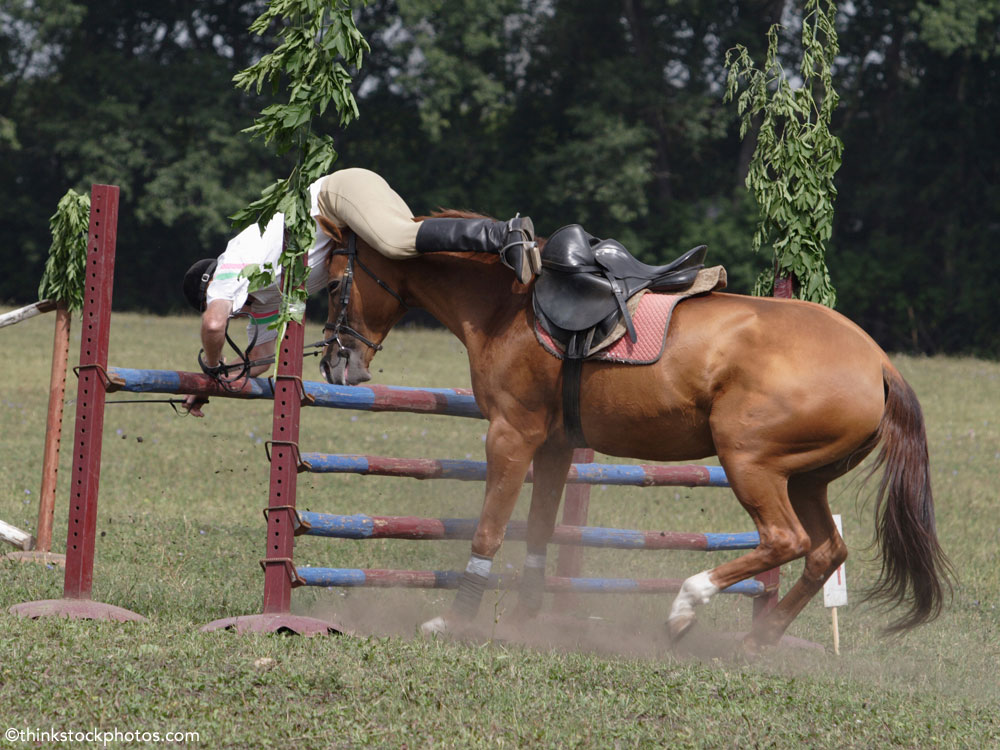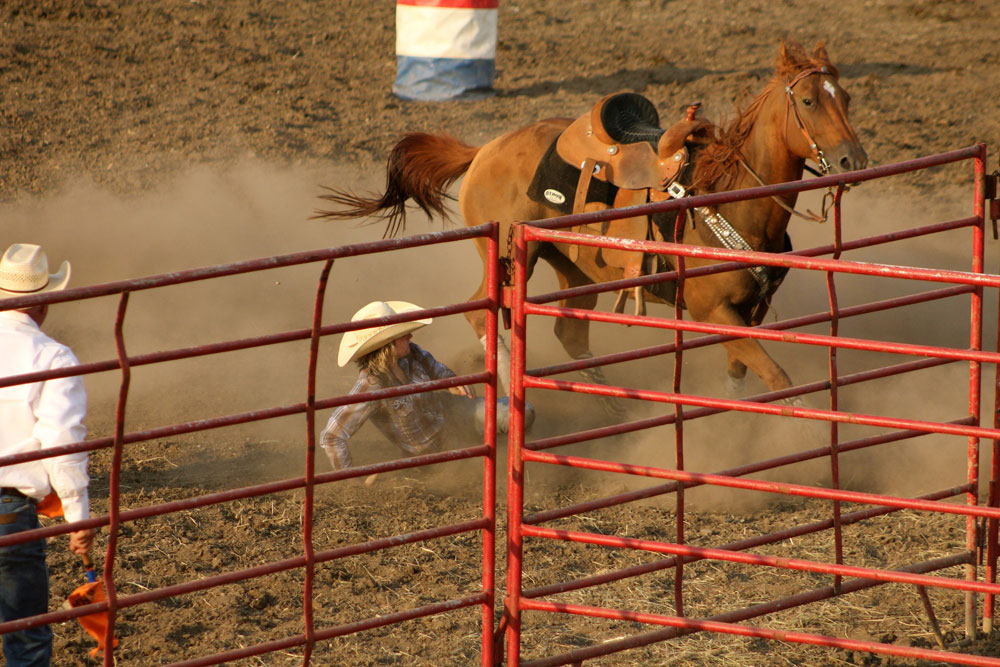Concussions have been in the limelight recently. The 2015 Golden Globe-nominated film “Concussion” starring Will Smith highlighted the health concerns stemming from repeated head trauma among National Football League (NFL) players.

What is a Concussion?
According to the Centers for Disease Control, a concussion is a type of traumatic brain injury (TBI) caused by a bump, blow or jolt to the head or a hit to the body that causes the head and brain to move back and forth rapidly. When that happens, the brain will bounce or twist around inside the skull, damaging the brain cells, thus creating chemical changes in the brain.
“A concussion will not have any imaging abnormalities,” explains Lola Chambless, M.D., a neurosurgeon at Vanderbilt University as well as a rider and eventer. “You won’t see anything on a CT scan or MRI with a concussion; the symptoms are purely a clinical diagnosis.”
An Increase in Information
There is a lack of data on head injuries for equestrians compared to other athletes.
This is somewhat surprising, considering equestrian activities have a higher hospital admission rate than motorcycle riding (0.49 versus 0.14 admissions for every 1,000 hours of activity), according to a recent study published in World Neurosurgery. This study also points out that horseback riding has the highest mortality rate of all sports, and higher rates of severe brain and total body injuries than rugby, automobile racing, football and skiing—combined.
So why the lack of information on equestrian-related brain injuries? Chambless believes that equestrian sport is difficult to study because it’s not as regulated as team sports. The majority of horseback riders ride primarily on their own time.
“With equestrian sports, most falls happen when you’re not at a sanctioned competition,” says Chambless. “Things like that happen all the time, and most people generally are not going to seek medical attention unless they are very symptomatic.”
This is the opposite of team sports. At sanctioned practices and events, if a player suffers from an injury during a practice or a game, there is a specific concussion protocol that the coach or trainer goes through to evaluate the player to see whether or not they should return to the field or if they need to be referred to a physician. (See “Concussion Clues,” below.)
“What I would love to see in equestrian sports and competition is a safety officer who is trained in concussion assessment, so if someone has a fall, they have to be checked out by that safety officer before they can be released to ride again,” says Chambless.
She would also like to see equestrian organizations offer seminars for coaches and trainers to learn how to perform a concussion assessment.
What About Helmets?
It’s smart to always wear a helmet when you ride to protect your head from major injury. Chambless points out that while ASTM-approved helmets reduce the chance of a lethal head injury and can save your life, they cannot completely prevent concussions.
“Helmets are designed to limit the types of forces that cause skull fractures and intracranial hemorrhage, which are things that are going to kill you or leave you with neurologic problems.
“Unfortunately, there is no safety gear out there currently that really reduces your chances of concussion from a fall of 6 feet, which is basically what you’re assuming you’re going to fall from in most equestrian injuries.”
After the Concussion
Most importantly, you must prevent secondary injury. Secondary injury occurs when a rider returns to the saddle before they’ve fully recovered from a concussion, putting them at a much greater risk for long-term or permanent issues.
If you wait for complete recovery prior to returning to full activity, Chambless says there is a 90-plus percent chance that there will be no long-term side effects from the concussion. However, if you return to the saddle early and re-injure yourself, that rate will drop significantly. Long-term side effects can include memory problems, thinking/cognitive issues, emotional and behavioral issues, and/or pain.
Chambless recommends waiting until your symptoms are completely resolved, then slowly returning to light cardio workouts (walking, jogging), then easing back into your riding (for example, going for a hack on a safe horse).
These steps can take a couple days or a few weeks depending on the severity of the concussion, but the idea is to slowly return to normal, and to consult a physician if anything seems wrong. At the absolute minimum, a break of 24 hours should be taken after the fall.
“I’d really like us to get rid of the ‘get right back on after a fall’ mentality, because it’s not good if you have a concussion,” says Chambless.
“If you get right back on a horse with the possibility of a concussion, you’re not riding your best, and a second fall can be much more severe. Any secondary concussion that occurs while you’re still recovering form the first is, by definition, much more severe, and potentially (on rare occasions) even life-threatening.”

Concussion Clues
The following five-minute sideline protocol is used by most major sporting groups to determine if an athlete should return to play or not. It doesn’t necessarily diagnose a concussion, but it can prevent further damage being done to the player if they were to return to action with a concussion.
“You don’t have to be a doctor to do the concussion protocol; it’s pretty straightforward,” says Chambless. Chambless is also a consultant with the NFL and works on the sidelines during games to help diagnose possible concussed players. The NFL’s guidelines are pretty simple:
- After observing a player suffering a suspicious hit (i.e., helmet to helmet), or if a trainer refers a player after a complaint (headache, blurred vision, dizziness, et cetera), the athlete is taken to the locker room, away from the high intensity of the game.
- Some fairly simple questions are asked, essentially testing immediate and short-term memory, which is most sensitive for diagnosing concussions. Those questions may include: Where are we playing today? What team are you playing against? What’s the score? What team did you play last week? Who won that game?
- If a player can’t answer one of those questions, then it is recommended that player not return to the field until a physician can see them.
“While these questions are football-specific, you can modify them for any sport,” says Chambless. “You might ask what horse show you’re at, what horse were you riding, et cetera.”
Take-Home Message
Chambless stresses that falls and injuries to the brain need to be taken seriously: Suffering a concussion could have ramifications throughout the rest of your life.
“We can’t prevent people from falling off, but we can make it a lesser risk by wearing a helmet and riding in safer situations,” she says. “But if you do fall off and get a concussion, as I have four times, you really need to give yourself time to heal adequately and take it seriously before you get back in the saddle. I didn’t do that early in my riding career, which is why I hammer the point home now.”
This article appeared in the July 2016 issue of Horse Illustrated magazine. Click here to subscribe!






I had a concussion as a child. I was an AAU swimmer and was running to ask my coach what to do next. I slipped and fell slamming my head into the concrete deck. It was 1968 and I was out in an air tent at the hospital. It was very frightening. I always wear a helmet when riding. You only have one brain